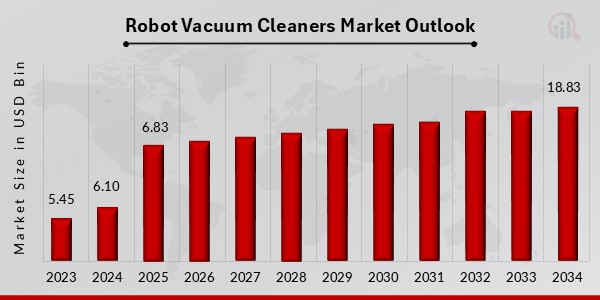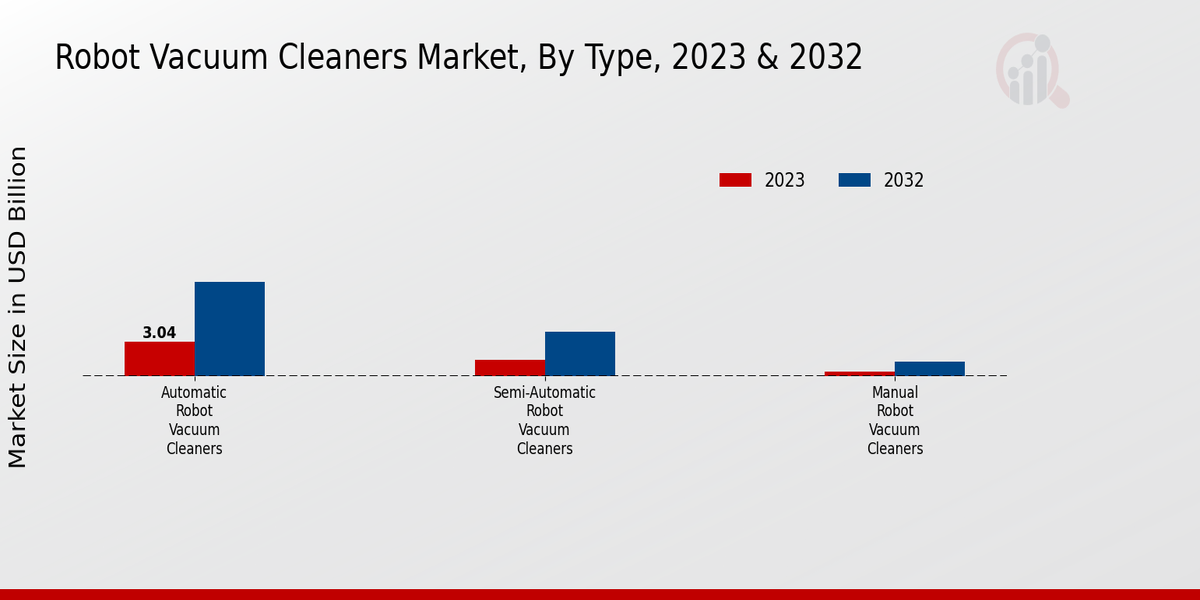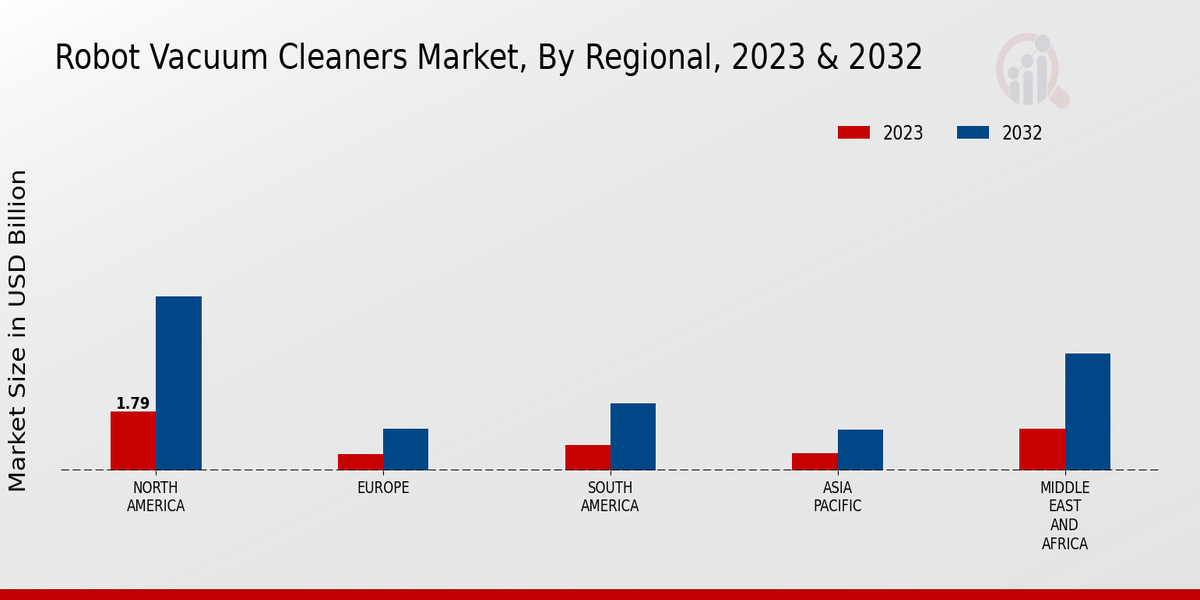Global Robot Vacuum Cleaners Market Overview
Robot Vacuum Cleaners Market Size was estimated at 6.10 (USD Billion) in 2024. The Robot Vacuum Cleaners Industry is expected to grow from 6.83 (USD Billion) in 2025 to 18.83 (USD Billion) by 2034. The Robot Vacuum Cleaners Market CAGR (growth rate) is expected to be around 11.93% during the forecast period (2025 - 2034).

Source Primary Research, Secondary Research, MRFR Database and Analyst Review
Key Robot Vacuum Cleaners Market Trends Highlighted
With ever-increasing convenience and automation demand and a rise in the number of working individuals, the robot vacuum cleaner market is witnessing growth. With such structures, cleaning will be done independently of human labor, which will result in less mess and free time for other mundane activities. In addition, technology has also improved self-emptying systems, AI mapping, and connection with smart home models.
The market has room to grow in new regions as more people dispose of their services. It is also benefitting from the advanced technology used in IoT and cloud computing, which gives scope for monitoring and scheduling from a distance.
Recent changes include the introduction of self-emptying robotic vacuums, which allow users to avoid the chore of disposing of the dustbin. Further, companies have set the aim to enhance facilities and optimally utilize space in order to provide effective cleaning without leaving any debris. Moreover, the proliferation of voice assistants and smart home devices is leading to the development of robot vacuum cleaners that can be operated and monitored by voice control.
Robot Vacuum Cleaners Market Drivers
Growing Popularity of Smart Homes
The smart home dynamic is one of the factors contributing to the growing robot vacuum cleaner market. Specifically, the increasing distribution and assimilation of smart home devices, such as smart speakers and smart lighting, into common daily routines dictate the need for a robot vacuum cleaner. Adding the device to a smart home setting implies that it may be controlled and scheduled via voice or mobile apps. Users may rely on task automation and convenience, leveraging smart technologies to maintain a clean home.In addition, as robot vacuum cleaners are considered parts of advanced technologies, they tend to incorporate smart technologies that use AI and Machine Learning to recognize and learn the floor layout and the most common obstacles for increased efficiency.
Technological Advancements and Innovation
The robotic vacuum cleaners market is dynamic due to technological advancement and innovation. The companies are spending on research and development to introduce new features in their product to enhance performance. Some of the key technological advancements include improved navigation systems, enhanced suction power, and longer battery life. Over time, robot vacuum cleaners are becoming more autonomous in operation, such as self-charging, avoiding obstacles, and creating an automatic floor map.These advances make the product more efficient and user-friendly and capable of handling a wider variety of cleaning tasks.
Rising Disposable Income and Changing Lifestyles
The factors contributing to the growth of the Robot Vacuum Cleaners Market Industry are rising disposable income and the changing lifestyles of consumers. The hectic pace of modern life and the increased demand for time are driving the need for products and services that can make things easier and consume less time. Apart from this, the growing number of working couples and single-parent families is contributing to the growth of the robot vacuum cleaner market.These small home appliances reduce the time spent cleaning and leave behind a clean space, which is important for many consumers as the world moves further into the digital age.
Robot Vacuum Cleaners Market Segment Insights
Robot Vacuum Cleaners Market Type Insights
The Robot Vacuum Cleaners Market segmentation by Type includes Automatic Robot Vacuum Cleaners, Semi-Automatic Robot Vacuum Cleaners, and Manual Robot Vacuum Cleaners. Automatic Robot Vacuum Cleaners are expected to dominate the market with a revenue of 6.94 Billion USD by 2024. They offer advanced features such as self-navigation, automatic charging, and obstacle avoidance, making them highly convenient and efficient for cleaning tasks. Semi-Automatic Robot Vacuum Cleaners are also gaining popularity, offering a balance between convenience and affordability.
They typically require some manual intervention, such as guiding the cleaner around obstacles or emptying the dustbin. Manual Robot Vacuum Cleaners are the most basic type, requiring manual operation and offering limited features. They are generally more affordable and suitable for smaller spaces or specific cleaning needs.

Source Primary Research, Secondary Research, MRFR Database and Analyst Review
Robot Vacuum Cleaners Market Shape Insights
The Robot Vacuum Cleaners Market is segmented into Round, Square, and D-Shaped robot vacuum cleaners on the basis of shape. Round Robot Vacuum Cleaners held the largest market share in 2023, which was more than 35% of the market. This is due to rising demand for robotic vacuum cleaners that has a variety of advanced and enhanced features, which is increasing the growth of the Round Robot Vacuum Cleaners segment. However, Square Robot Vacuum Cleaners are expected grow at a CAGR of over 15% over the coming years due to their cleaning ability to access and clean hard-to-reach areas and corners effectively.D-Shaped Robot Vacuum Cleaners are in demand by most of the customers owing to their efficient cleaning ability and is expected to grow at a CAGR of over 13% over the coming years.
Robot Vacuum Cleaners Market Target Surface Insights
The Robot Vacuum Cleaners Market is segmented based on Target Surface into Hard Floor Robot Vacuum Cleaners, Carpet Robot Vacuum Cleaners, and Both Hard Floor and Carpet Robot Vacuum Cleaners. Hard Floor Robot Vacuum Cleaners accounted for the largest revenue share in 2023, owing to the increasing adoption of hard flooring in residential and commercial spaces. Carpet Robot Vacuum Cleaners are expected to witness significant growth over the forecast period, due to the rising demand for deep cleaning solutions for carpets. Both Hard Floor and Carpet Robot Vacuum Cleaners offer versatility and convenience, catering to both types of flooring surfaces.The growing popularity of smart homes and the integration of advanced technologies, such as AI and IoT, are further driving the demand for Robot Vacuum Cleaners across all Target Surface segments.
Robot Vacuum Cleaners Market Self-Emptying Capability Insights
The self-emptying capability segment in the Robot Vacuum Cleaners Market is witnessing significant growth, driven by the increasing demand for convenience and automation in household cleaning. Self-emptying robot vacuum cleaners automatically empty their dustbins into a dedicated disposal unit, eliminating the need for manual emptying. This feature offers numerous benefits, including improved hygiene, reduced maintenance, and enhanced user experience. In 2023, the self-emptying robot vacuum cleaners segment accounted for approximately 35% of the Robot Vacuum Cleaners Market revenue, and it is projected to grow at a CAGR of 13% during the forecast period 2024-2032.The growth is attributed to the increasing adoption of smart home devices, technological advancements, and rising disposable income. Key market players are continuously innovating and introducing advanced self-emptying robot vacuum cleaners with features such as mapping and navigation capabilities, voice control, and smartphone integration. This segment is expected to gain further traction in the coming years as consumers prioritize convenience and efficiency in their daily lives.
Robot Vacuum Cleaners Market Regional Insights
The Robot Vacuum Cleaners Market is segmented into North America, Europe, APAC, South America, and MEA based on region. North America is expected to hold the largest market share due to the high adoption of advanced technologies, rising disposable income, and increasing awareness of cleanliness and hygiene. The APAC region is projected to grow at the highest CAGR due to the increasing urbanization, growing middle class, and rising demand for convenience and automation. Europe is anticipated to have a significant market share due to the presence of major players, technological advancements, and increasing consumer spending on home appliances.South America and MEA are expected to experience steady growth due to the growing demand for smart home devices and increasing disposable income.

Source Primary Research, Secondary Research, MRFR Database and Analyst Review
Robot Vacuum Cleaners Market Key Players And Competitive Insights
Key players in the Robot Vacuum Cleaners Market industry are always working to outperform themselves to stay ahead of the competition. Leading players in the Robot Vacuum Cleaners Market are focusing on research development and innovation to serve the increasing demand for smart home cleaning aids. The Robot Vacuum Cleaners Market is characterized by tough competition, with multiple established players and emerging start-ups eager to tap into the market.iRobot is a prominent company in the Robot Vacuum Cleaners Market that is famous for producing Roomba products. iRobot’s Roomba vacuums come with advanced navigation systems and powerful suction mechanisms. The company is known for offering smartphone connectivity for virtual home cleaning. iRobot has also acquired favorable brand recognition and, hence, enjoys a substantial customer market. Apart from Roomba vacuum cleaners, iRobot also produces Braava mops and AirMini air purifiers.
Founded in 1998, Ecovacs Robotics is another key player in the Robot Vacuum Cleaners Market. The company is also known for producing a wide range of Deebot products. The versatility of Deebot vacuum cleaners lies in the fact that they can navigate complex floor plans and perform their functions with supreme longevity. In addition to vacuum cleaners and floor washing aids, Ecovacs also produces Windoro window cleaners and Winbot window cleaners. Since its launch in 2008, the company has also actively worked on integrating its products into smart home devices.
Key Companies in the Robot Vacuum Cleaners Market Include
- ECOVACS
- Roborock
- Lefant
- Samsung
- Neato Robotics
- iLife
- Bissell
- Dreame
- Haier
- iRobot
- LG
- SharkNinja
- Xiaomi
- Hoover
Robot Vacuum Cleaners Market Industry Developments
The robot vacuum cleaner market is expected to grow significantly in the coming years. Key factors driving this growth include the increasing popularity of smart home devices, the growing number of working women, and the rising demand for convenience.Recent developments in the market include the launch of new products with advanced features, such as self-emptying bins and improved navigation systems. Major players in the market are also investing in research and development to improve the performance and functionality of their products.In terms of market size, the robot vacuum cleaner market is expected to reach USD 13.42 billion by 2032, growing at a CAGR of 11.93% from 2024 to 2032.
Robot Vacuum Cleaners Market Segmentation Insights
- Robot Vacuum Cleaners Market Type Outlook
- Automatic Robot Vacuum Cleaners
- Semi-Automatic Robot Vacuum Cleaners
- Manual Robot Vacuum Cleaners
- Robot Vacuum Cleaners Market Shape Outlook
- Round Robot Vacuum Cleaners
- Square Robot Vacuum Cleaners
- D-Shaped Robot Vacuum Cleaners
- Robot Vacuum Cleaners Market Target Surface Outlook
- Hard Floor Robot Vacuum Cleaners
- Carpet Robot Vacuum Cleaners
- Both Hard Floor and Carpet Robot Vacuum Cleaners
- Robot Vacuum Cleaners Market Self-Emptying Capability Outlook
- Self-Emptying Robot Vacuum Cleaners
- Non-Self-Emptying Robot Vacuum Cleaners
- Robot Vacuum Cleaners Market Regional Outlook
- North America
- Europe
- South America
- Asia Pacific
- Middle East and Africa
| Report Attribute/Metric |
Details |
| Market Size 2024 |
6.10 (USD Billion) |
| Market Size 2025 |
6.83 (USD Billion) |
| Market Size 2034 |
18.83 (USD Billion) |
| Compound Annual Growth Rate (CAGR) |
11.93% (2025 - 2034) |
| Report Coverage |
Revenue Forecast, Competitive Landscape, Growth Factors, and Trends |
| Base Year |
2023 |
| Market Forecast Period |
2025 - 2034 |
| Historical Data |
2019 - 2023 |
| Market Forecast Units |
USD Billion |
| Key Companies Profiled |
ECOVACS, Roborock, Lefant, Samsung, Neato Robotics, iLife, Bissell, Dreame, Haier, iRobot, LG, SharkNinja, Xiaomi, Hoover |
| Segments Covered |
Type, Shape, Target Surface, Self-Emptying Capability, Regional |
| Key Market Opportunities |
Growing demand for smart home appliances Rising disposable income in developing economies Technological advancements leading to improved functionality Increasing consumer awareness about hygiene and convenience Expansion of ecommerce channels |
| Key Market Dynamics |
Rising demand technological advancements increasing affordability expanding distribution channels growing preference for convenience |
| Countries Covered |
North America, Europe, APAC, South America, MEA |
Frequently Asked Questions (FAQ) :
The Robot Vacuum Cleaners Market is projected to reach a value of approximately USD 18.83 billion by 2034.
The Robot Vacuum Cleaners Market is anticipated to register a compound annual growth rate (CAGR) of around 11.93% from 2025 to 2034.
The Asia-Pacific region is anticipated to dominate the Robot Vacuum Cleaners Market during the forecast period, owing to increasing urbanization and rising disposable income in countries like China and India.
Factors such as growing demand for convenience and automation in household chores, advancements in technology leading to improved functionality and features, and rising consumer awareness about the benefits of robot vacuum cleaners are driving the market growth.
Key players in the Robot Vacuum Cleaners Market include iRobot, Ecovacs, Xiaomi, Samsung Electronics, and LG Electronics, among others.
Robot Vacuum Cleaners find applications in residential and commercial settings, including homes, offices, hotels, and healthcare facilities, among others.
The Robot Vacuum Cleaners Market is segmented by product type (basic, self-emptying, and robotic mops), price range (low, mid, and high), distribution channel (online and offline), and region (North America, Europe, Asia-Pacific, and Rest of the World).
Emerging trends include the integration of artificial intelligence (AI) and advanced sensors for enhanced navigation and obstacle avoidance, the development of self-cleaning and self-charging models, and the growing popularity of robotic mops.
Challenges faced by the Robot Vacuum Cleaners Market include concerns over privacy and data security, high costs, and limited functionality in complex environments.
The Robot Vacuum Cleaners Market is projected to continue its growth trajectory in the coming years, driven by advancements in technology, increasing demand for convenience, and growing consumer awareness about the benefits of these devices.

















